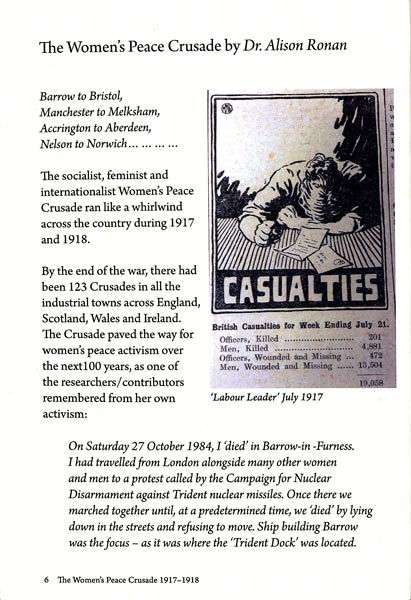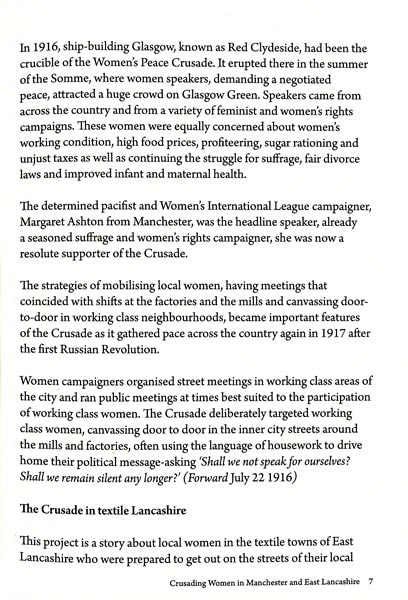
'THE GREAT WAR', 'THE WAR TO END WAR', 'WORLD WAR 1'
'What passing-bells for these who die as cattle?
- Only the monstrous anger of the guns.'
from 'Anthem for Doomed Youth'
by Wilfred Owen
From the Publication 'The Women's Peace Crusade, 1917-1918 : Crusading Women in Manchester & East Lancashire' |
|
|
'The Women's Peace Crusade' by Dr. Alison Ronan
The socialist, feminist and internationalist Women's Peace Crusade ran like a whirlwind across the country during 1917 and 1918. By the end of the war, there had been 123 Crusades in all the industrial towns across England, Scotland, Wales and Ireland. The Crusade paved the way for women's peace activitism over the next 100 years, as one of the researchers / contributors remembered from her own activism:
Page 6
|
|
In 1916, ship-building Glasgow, known as Red Clydeside, had been the crucible of the Women's Peace Crusade. It erupted there in the summer of the Somme, where women speakers, demanding a negotiated peace, attracted a huge crowd on Glasgow Green. Speakers came from across the country and from a variety of feminist and women's rights campaigns. These women were equally concerned about women's working conditions, high food prices, profiteering, sugar rationing and unjust taxes as well as continuing the struggle for suffrage, fair divorce laws and improved infant and maternal health. The determined pacifist and Women's International League campaigner, Margaret Ashton, from Manchester, was the headline speaker, already a seasoned suffrage and women's rights camp[aigner, she was now a resolute supporter of the Crusade. The strategies of mobilising local women, having meetings that coincided with shifts at the factories and mills and canvassing door-to-door in working class neighbourhoods, became important features of the Crusade as it gathered pace across the country again in 1917 after the Russian Revolution. Women campaigners organised street meetings in working class areas of the city and ran public meetings at times best suited to the participation of working class women. The Crusade deliberately targeted working class women, canvassing door-to-door in the inner city streets around the mills and factories, often using the language of housework to drive home their political message - asking 'Shall we not speak for ourselves? Shall we remain silent any longer?' (Forward July 22 1916) The Crusade in textile Lancashire This project is a story about local women in the textile towns of East Lancashire who were prepared to get out on the streets of their local Page 7 |
Go to Pages 8 & 9 Go to Pages 10 & 11
Return
to Peace Crusade Project page & Book Contents List |
Return
to Campaigning for Peace page |
If you have Oldham and District items that we can include on our website, PLEASE visit the information page to find out how you can help.

